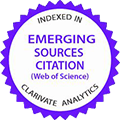The Impact of Electricity Production Sources and GDP on CO2 Emission in Bangladesh: A Short-run Dynamic
DOI:
https://doi.org/10.28992/ijsam.v5i2.345Keywords:
ARDL, CO2 emission, electricity, GDP, short-run dynamics.Abstract
This study aims to measure the short-run dynamics of electricity production sources and GDP on CO2 emission in Bangladesh. As a developing nation, Bangladesh needs to generate more electricity to cater to the demands of households and firms. However, environmental degradation due to energy utilization, industrialization, and economic expansion has negative consequences. The current study applies the Autoregressive Distributed Lag (ARDL) approach by considering the time series data from 1972 to 2018. The findings showed that the short-run association with ECT is 25% and 1% increase in electricity production raises the CO2 emission by 0.63%. The GDP has no significant impact on CO2 emission in the short run. The current study recommends that modern technologies like small power producers (SPP), solar panels, recommends that other renewable technologies can be used as alternatives to electricity production. Through small power producers, the country can meet the electricity demand for households and small firms. This study will create awareness on the need for sustainable electricity production by considering lesser environmental damages.

